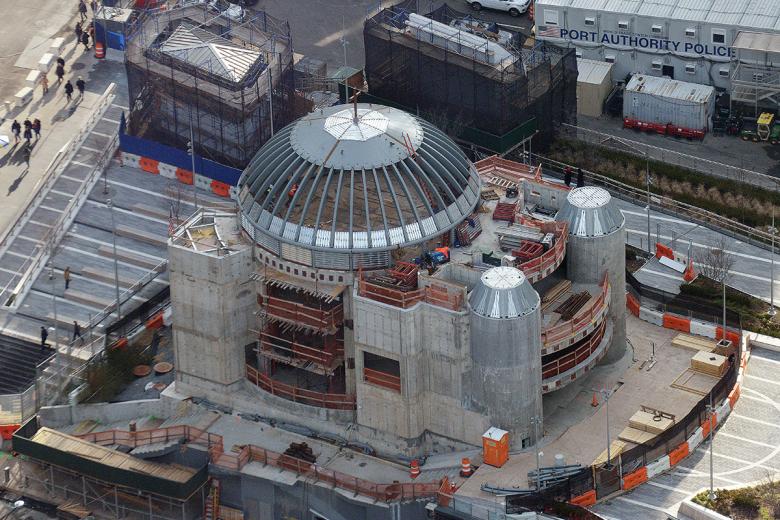Construction of Calatrava Church Resumes
John Hill
4. August 2020
Construction of St. Nicholas Church in December 2016 (Photo: Harvey Barrison/cropped via Wikimedia Commons)
Construction of St. Nicholas Greek Orthodox Church, designed by Santiago Calatrava to replace the 82-year-old church destroyed on September 11, 2001, resumed this week after years of sitting idle.
Santiago Calatrava's design, inspired by the Hagia Sophia in Istanbul, was unveiled in 2013, when a 2017 opening was targeted. Construction started in 2014 and the structure overlooking the World Trade Center site in Lower Manhattan topped out in 2016, but then delays set in. As described by the New York Post, these included "rampant cost overruns amounting to millions of dollars; legal squabbles between the church and the Port Authority, which owns the Liberty Street site of the new St. Nicholas; and top church executives being convicted or accused of pilfering funds meant for the project."
With New York Governor Andrew Cuomo stepping in earlier this year to reboot construction, the church — officially the St. Nicholas Greek Orthodox Church and National Shrine — is now aiming for a September 11, 2021, opening, marking the 20th anniversary of the terrorist attacks on the World Trade Center.
The original church, housed in a 19th-century tavern, opened in 1919. One block away from the World Trade Center built a half-century later, the church was destroyed when the south tower fell. It was the only house of worship destroyed on September 11.
On Monday, August 3, Archbishop Elpidophoros, head of the Greek Orthodox Archdiocese of America, spoke alongside Cuomo at the site of the church, which received its first piece of glass that will comprise its dome. In his remarks, Elpidophoros mentioned the inspiration of Calatrava's design, but he also decried how "the greatest church in the world was taken away from the world in an act of domination and chauvinism," referring to Turkish president Erdoğan ordering the reclassification of Hagia Sophia as a mosque, which took effect on July 24.
As illustrated in the short film above, Calatrava's design was inspired by the massing of the Hagia Sophia, built in the sixth century as the cathedral of Constantinople, as well as mosaics within what is now the Hagia Sophia Grand Mosque. The relatively simple, symmetrical design is Calatrava's second building at the WTC site, following the PATH Terminal, which opened in 2016 after its own delays and controversies. The most striking aspect of the Spanish architect and engineer's monolithic design is the way it will glow after sunset, illuminated from within through the glass expanses between the corner piers.
As Elpidophoros told the Post, "Finally, the only House of God destroyed on Sept. 11 will be completed and open to all people, on the twentieth anniversary of that fateful and horrific day. We look forward to welcoming New Yorkers and the entire world to this sacred space dedicated to memory, faith, and freedom."
Related articles
-
Construction of Calatrava Church Resumes
on 8/4/20
